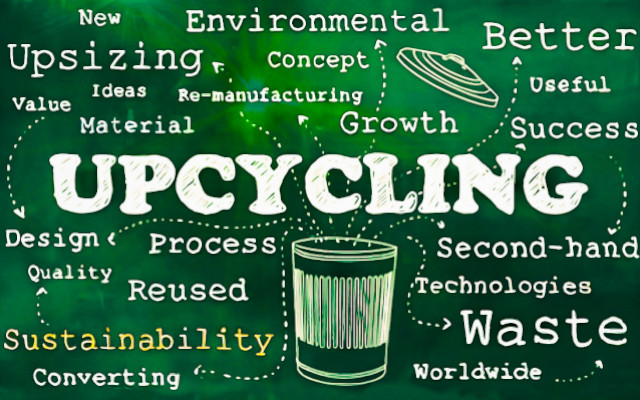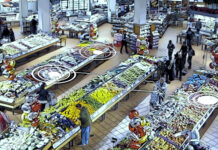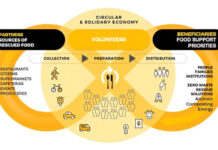Upcycling-that is, enhancing the side streams of processes, in agrifood supply chains as in others-is the magic word to look to in any research and innovation activity. (1)
Natural resources are limited and their availability increasingly uncertain, due to geopolitical and climatic factors. Circular economy is a common requirement for every system. (2)
Automation and digitization, data collection and processing through AI(Artificial Intelligence) should therefore be geared to serve this primary goal.
1) Upcycling, the concept
The concept of upcycling encompasses any form of ameliorative reuse of materials otherwise destined for recycling in lower-value-added supply chains (e.g., from food to feed), rather than energy valorization or waste disposal.
Thus, upcycled foods are foods that reuse (at least in part) co-products and scraps from other productions, otherwise intended for uses other than human consumption. With a favorable impact on the environment and society.
2) Sustainable innovation
The five pillars of sustainable development-People, Planet, Prosperity, Peace and Partnership-find convergence in the sharing of participatory models (open innovation) aimed at optimizing the efficiency of use of available resources and redistributing their benefits.
Upcycling in agrifood supply chains is an innovation that accords the needs of:
- economy (new value to recovered raw materials of lower cost than the original ones),
- environment (less pressure on ecosystems, in the production and disposal of waste and refuse),
- Social (food waste reduction, food accessibility).
3) First goal, reduce waste
Food waste is distinguished into food losses (foodloss)-from primary agricultural production, to distribution to the consumer excluded-and food waste (foodwaste), at later stages. Their estimates in the EU remain entirely approximate, pending the establishment of reliable measurement criteria. (3)
Eurostat (2022) estimated food waste in the EU in 2020 at about 57 million tons (down 45 percent from the 88 mln t estimated in 2014. See note 3), with a market value of about € 130 billion. 127 kg of food waste per inhabitant, broken down as follows:
- 45% food loss (leakage). In food and beverage processing first (18 percent), followed by primary agricultural production (11 percent), catering (9 percent) and distribution (7 percent),
- 55% food waste. Waste, or surplus, generated by consumers (70 kg per capita). Although an estimated 36.2 million inhabitants were unable to afford two adequate meals each day.
4) Practical applications. From food loss and food waste toupcycling
Wastes-in vegetable(e.g., fruit and vegetable peels and seeds, cereal and legume co-products) and animal (e.g., waste from the fish supply chain)-can be used as raw materials in new food production processes, instead of making food losses.
Food surpluses-which should first be prevented, systemically (2)-can in turn be subjected to new food processing, or donated to charities(food banks), to reduce food waste. (4)
5) Circular bio-economy and food recovery hierarchy.
The concept of a ‘circular bioeconomy’ is proposed in a recent study (Klein et al., 2022) to propose a ‘hierarchy of strategies for preventing food surpluses, by-products and food waste.’ (5) The de facto researchers apply the waste hierarchy, or Lansink scale, to agrifood supply chains (Fig. 1).

The ‘value pyramid’ displayed in the study ranks the different options for processing waste and surplus, having regard to their added value and level of sustainability. To promote economic growth through eco-innovation, but also vertical integration in the value chain, across industries and with institutions (6,7).
6) Interim Conclusions
The year 2030 is approaching and the planet’s greatest challenge-achieving Sustainable Development Goal No 2, Zero Hunger-is getting further and further away still in search of solutions. (8)
The only solution available today in every supply chain and industry, regardless of policy decisions, is preciselyupcycling. To integrate social, environmental and economic goals.
#Wasteless
Dario Dongo
Notes
(1) Dario Dongo, Andrea Adelmo Della Penna. Upcycling, ameliorative reuse in the food supply chain. GIFT (Great Italian Food Trade). 6.10.21
(2) Giulio Vulcano, Dario Dongo. Food waste, a systemic approach to address the ecological and social crisis. GIFT (Great Italian Food Trade). 17.3.19
(3) Dario Dongo. Food waste in the EU, a common measurement method is coming. GIFT (Great Italian Food Trade). 22.6.19
(4) Dario Dongo, Andrea Adelmo Della Penna. Redistribution and donation of food surpluses, the ABCs. GIFT (Great Italian Food Trade). 11.11.22
(5) Klein, O., Nier, S. and Tamásy, C. (2022), Towards a Circular Bioeconomy? Pathways and Spatialities of Agri-Food Waste Valorisation. Tijds. voor econ. en Soc. Geog., 113: 194-210. https://doi.org/10.1111/tesg.12500
(6) European legislation may in turn require some reforms. For example, to enable the reuse of animal by-products under conditions that can ensure the highest levels of food safety. As well as to promote upcycling activities and their reporting. This will be worked on in the Wasteless research project, in Horizon Europe
(7) Dario Dongo, Andrea Adelmo Della Penna. Wasteless, EU research project on circular economy and blockchain. GIFT (Great Italian Food Trade). 5.9.22
(8) Sabrina Bergamini. The hunger pandemic does not stop. Zero hunger is a mirage. Égalité. 24.12.22
Dario Dongo, lawyer and journalist, PhD in international food law, founder of WIISE (FARE - GIFT - Food Times) and Égalité.








